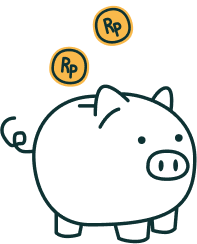
How We Invest
Summary
We buy if all of the following is true:
- Company has a good track record and good product
- Company has a good management
- Company is sold at a discount

We sell if:
- Company has reached intrinsic valuation that is calculated by our team OR
- Investment thesis is wrong (happens) OR
- there are other companies that have way more attractive margin of safety
Our Investment Framework
We see buying a stock as buying a piece of a real business. So instead of focusing only on price charts or market sentiment, we ask a simpler, more grounded question:
If I owned this business, how many years of earnings would it take to earn back what I paid?
We call this the Fair Payback Period—not because the business will literally return your cash, but because it helps us understand whether the business can justify its price based on what it earns.
It's like buying a small coffee shop for 1 billion rupiah. If that shop makes 100 million in profit per year, you'd earn back your investment in 10 years. That's the idea.
Stocks work the same way—behind every ticker is a business generating profits. We look at how long those profits would take to match the price we're being asked to pay.
A Common-Sense Benchmark
Now, imagine you have another option: a government bond. Indonesia's 10-year bond currently pays around 6.5% per year. That's predictable and low risk—and it means you'd "earn back" your investment in about 15 years.
If a stock requires more than 15 years of earnings to match the price we're paying, we think twice. If it's less than 15 years, then we're at least being compensated for the extra risk of owning a business.
Stocks come with uncertainty—competition, mismanagement, economic ups and downs. So the return should be worth it. This approach keeps us honest.
We're not buying just because the price dropped or the story sounds exciting—we're buying because the underlying business makes sense.
Not All Businesses Are Equal
Some businesses are steady and predictable. Others are more cyclical or uncertain. So we adjust our expectations based on the kind of business we're looking at.
We ask:
- Does it have a strong edge over competitors?
- Are profits stable or growing or declining?
- Is the company careful with debt?
- Do they pay dividends fairly and consistently?
The stronger and more reliable the business, the more years we're comfortable waiting.
Figuring Out a Fair Value (without the jargon)
When we buy a stock, we're buying a piece of a business. So to figure out if the stock is fairly priced, we ask:
"If I owned the whole business, what would be a fair price to pay based on what it earns?"
We get Fair Price from its the Fair Value (note: price is value divided by number of shares). And we estimate it using a simple formula:
Fair Value = Fair Payback Period × Realistic Yearly Earnings
Why Realistic Earnings Matter?
Some industries (like coal, nickel, or palm oil) go through boom-and-bust cycles. In boom years, profits might look huge—but we don't just take that at face value. We ask: What can this company earn in a normal year? That's the number we use.
Example: A Manufacturing Company
- We estimate the company can earn IDR 100 Bio per year, consistently.
- We think it's fair to wait 10 years to earn back what we paid (Fair Payback Period = 10 years).
Fair Value = 10 × IDR 100 Bio = IDR 1 trillion.
If the stock market currently values the company at only IDR 700 Bio, we might see it as undervalued. But if it's already priced at 1.5 trillion, we might pass—it's too expensive for what it earns.
When Do We Buy?
We don't buy at fair value—we buy below it.
That discount gives us a margin of safety. It protects us if our assumptions are off, or if the market stays negative longer than expected.
And if the business stays strong while the market recovers, the price usually follows. In the meantime, we may collect dividends and hold a business we believe in.
When Do We Sell?
- We sell if companies we invest in has reached its Fair Value.
- We sell to switch to a new opportunity with much higher margin of safety. Holding on to stocks with lower margin of safety while seeing stocks with much higher margin of safety has an opportunity cost.
- We sell if our investment thesis is wrong (we are humans that make mistakes).
Closing Remarks
We invest with caution, clarity, and a long-term mindset. We do not chase hype. We focus on fair value and being paid for the risks we take.